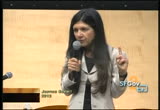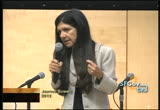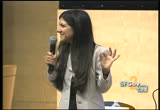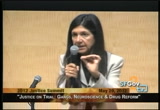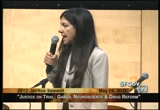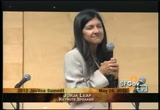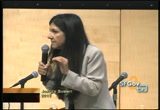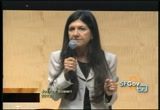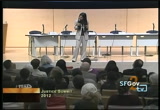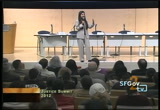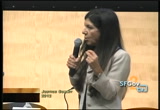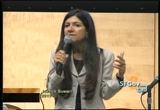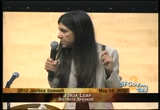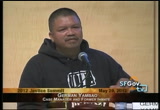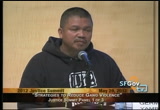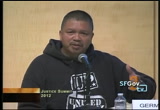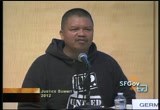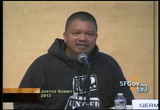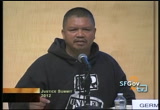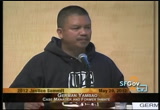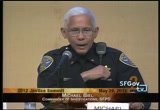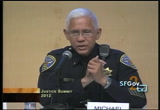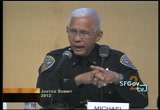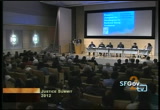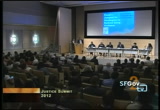tv [untitled] January 22, 2013 12:30am-1:00am PST
12:30 am
this is the first major force in the denunciation. the second is legal assistance. surprising. you did not see this on the video and i never thought of this. the first thing individuals need, not to feel like gang members -- is to erase their past. they have literally talked with me about feeling -- removing these tattoos and legal excitement. it is not that simple. changing from being a gang member to a former gang member involves a change in identity. this is a tricky process.
12:31 am
it is slow and steady, and there is frustration. the gang is replaced with drugs, and there are fallbacks. relapses, connections, there are struggles. this is where collaboration needs to take hold. it has now become a cliche, to say that we cannot rest on our way out of this problem. i no longer want to hear those words. this is not to give the law- enforcement a short shrift. i have had an impact on my husband's life, some of the unwanted. but he has had an impact on
12:32 am
mind. i have done extensive work with law enforcement, with the lapd and the los angeles county sheriff's. i am here to tell you that crime has been driven down in los angeles because of their efforts, but not only because of their efforts. so what does the collaboration look like. i want you to keep some ideas in mind. there is no first among equals. what we learned in los angeles was that oppression alone was not the answer. it did not work. there were record highs in gang violence in 2005.
12:33 am
i want to tell you what has happened between 2005 and 2012. number one, the grass roots -- the disorganize, fragmented, passionate grass roots must be part of this. the community members who go to county supervisors meetings, the members who pass out fliers, the youths who have been in the juvenile justice system that are now part of the coalition -- those individuals must have a seat at the table. no. 2. community-based organizations. that operate on a shoestring and often without any kind of coverage anywhere. they must be legitimized and made part of the conversation.
12:34 am
i have witnessed this with homeboy industries. how many people have heard about this? in california i rarely have to worry. i was in green bay and i started to talk about father greg and no one had any idea what i was talking about. i have known greg boyle for 25 years. i worked with him when he routinely received death threats. people believed he was trying to help gang members. the lapd called him a hug- hugger. i will repeat everything that they have said, not because of sore afraid of using profanity but because it was a different lapd.
12:35 am
it was rumored that the mexican mafia was allowed to meet in his church and that he held guns for gang members. and he was helping gang members across the border. i am certain he knew where the body of jimmy hoffa was buried when you got done listening to the rumors. now, the lapd uses home with industries as an integral part of its anti-gang efforts. not all of them, not 9000 members, but i can tell you this, homeboy industries have their annual benefit to honor people in the community as well as former gang members, the person they honored was chief charlie of the lapd. unless you think that was an
12:36 am
anomaly, the year before they honored the sheriff. there is an alliance between community-based organizations, and law-enforcement. this is not enough. there has also been in the streets, ongoing, a relationship, a delicate one, a thoughtful one between the loss angeles police department and gang intervention. interventionists are former gang members. they have to be very careful about how they play out the relationship. they do not want to be snitches. but they want to stop the bleeding. i cannot tell you the complete
12:37 am
shock that i have felt as i have sat down with veteran members of the lapd staff, and they talked about the important work of gang intervention. this is not lip service, this is reality. and then i bring up the most important part of collaboration. it has to do with helping young people, whether they are at risk of joining gangs, or if they want to leave gangs. either one, they need help building their identities. they need help with sang an alternative to the gang life. they need someone who is interested in them. i am going to tell you a story, and i will talk about who those
12:38 am
people are. when i was a sweet young thing and a social worker in nickerson gardens, i had that one kid. every gang interventionist, every person in this room knows about that one kid. all of us have that kid. they touch us for reasons we cannot articulate. i don't know why bobby touched me, his name was little devil but i never wanted to call him by that name. i think about his personality and that maybe the reason. he was 14 years old and had been abused, and was in foster placement with his hat -- aunt.
12:39 am
i fell in love with him in the most proper, loving, in the most big sister way. i would say to him, with all the ignorance of the young social worker, i will always be here for you, always. always. it was a friday night, and i had gone on a string of disasters states, this was in the 1980's. we hooked up, but said we didn't. it was 2:00am and i was getting home. i lived in venice, california. the rent was affordable.
12:40 am
but this was to in the morning. the house had a wraparound porch. i was walking up to my house, and there was a shadowy figure on the porch. i did what any concert -- god- fearing a young woman did. i reached for my can of mace, and i was prepared. i looked at the chateau -- shadow, and i heard the voice and knew it was bobby. with all the sensitivity of a new social worker i said, what the -- are you doing here? he told a story that his foster
12:41 am
uncle, worked at martin luther king hospital. he convinced his uncle to break into my personnel file. he got my personnel file and my address, there is no transportation in los angeles -- there is nothing. he took three buses and hitchhiked, making it to my old frame house in venice. i said, why are you here? he said i was in a car and we did drive by and i don't know what to do. you said you would always be
12:42 am
there for me. there's the answer and the question. how are we always going to be there for bobby. how are we going to help young people at risk, people who are active, to build new identities? we begin with tattoo removal, legal expunged and and we work on attachment. every individual who wants to avoid being in a gang, who wants to leave the game, they need a role model and mentor, they need someone to be there. there is no single type of person. we need it the merging of former gang members, prosecutors and
12:43 am
social workers and public defenders. you have all had that kid. he needs role models, job training, and real jobs. i was happy to hear that in the video, nothing stops the bullet like a job. we need to provide that. bobbie ann smiley did not ask for their fates. a young woman i worked with, who has five children and has been a member of valencia 13, and finally once to leave the gang, she did not ask for her fate. we need to listen to the needs -- providing them with jobs,
12:44 am
with law enforcement and the community, we need to merge. you need to collaborate. you cannot speak to one another, you need to talk together. this is the challenge. i want to urge everyone in the audience, i take strength from those words, from that question as bobby threw down the gauntlet 30 years ago. you said you would always be there for me. meaning, the there in force, together with the understanding. thank you very much.
12:45 am
>> let me begin this the scutcheon. you work every day with gang members. you were once a gang member yourself. why do you think you are effective working with young people and what does this mean to you and how we know that this is working. first of all, i want to thank god for his grace. i work with united players. i do reentry and the youth involved in juvenile delinquency. the majority of the kids i work with our gang members. i was formally -- formerly a gang member who grew up in san francisco. we all have stories of guys involved with the gang. everyone has a different story of why they joined.
12:46 am
my thing is, i believe it works for me to be involved with kids who were in gangs -- i worked with all of the shot colors and i had a goal while i was there. it took me 10 years before i started to transform my life. in the meantime i have the goal that i wanted to be out here. i wanted the opportunity. i was given a life sentence in 1979. i was involved in gang and i caught a murder case. 15 years to life -- and i came here in 1979 and i got out -- and i have been out for almost five years. in my heart, i knew i found a
12:47 am
solution when i was incarcerated. and there are different stories. some of the kids joined the gangs because they want to fit into something. some of them don't have a family, and the father and mother are working. for a lot of kids, there is a lot of idle time. it is not like, i will join the gang and i will shoot you. you grow up that way, and before you know you are cutting school. this is begins. working with the different kids that we have, the gangs are still the same -- the game is still the same and the players have changed.
12:48 am
some of these kids are savage. i can look in their eyes. they can go way out -- what works for me is to get their trust. i don't tell them, drugs are bad and this is bad. if you can figure out where this began you can follow this. and why did i join a gang? what attracted me, it was the power that came with it. there was no money involved and nothing involved. we all have different stories. and we have to adjust.
12:49 am
12:50 am
i work with gang members, and they never knew that they were gang members. things have changed their. they isolate themselves. this is so small that they cannot go anywhere. the thing with me, with the kids, is just being able to love them. this does not take you yelling at somebody. all they need is the information. sometimes you go through this maze, and there is a dead-end
12:51 am
street. i am just coming back. i am giving them information that this is not the way to go. there is no certificate for you. you were the gangster of the year. it does not work for everybody. i save the community a lot of heartache. with the crime that he would comment, just one is worth it for me. [applause] >> commander beale.
12:52 am
we hear a lot of discussion about gang interventionists. how should san francisco's gang task force work with these programs? >> well, i'll tell you. i became the commander of investigations a year ago. this is new to me. what i saw was what the men and women do. this was nothing less than amazing. what the task force does is the majority of the contact that they have with the community, it is really about information sharing, talking and getting to know the people, the families, and they do a lot of work in the intervention field as well as
12:53 am
the prevention. with this task force, what they have to do is build those relationships. you cannot do that, with the police and the radio car. you have to get to know them. you have to know them when they are hurting. that is what amazed me. i went into the task force office. i ask them, what is this about? they have adopted the families into the worst housing projects in our city. their own funds that they put together, they will go out to get young kids.
12:54 am
this will build those relationships. what they do, if you work in the community network, this is the guidance of youth and their families. they are made up of former gang members. what they did when they took over as the commander, is to ask them what is going on. i asked her, what can we do to make this better? but i did then, after the discussion i brought in these captains to meet with the personnel. the actual formal gatt -- former gang members. i told them we have to work together. so that when we have an
12:55 am
instance of a homicide or a shooting, we can work together to do the prevention piece of this to prevent retaliation and emotional anchor. what we have decided then, the reason why the crn is cold, at the scene of the incident. they do not communicate with the officers. they are in a precarious situation. they worked at a much closer environment and they cannot be perceived as a snitch. or that they are working with the police department. they are there to, down, emotionally, the anchor. what they do then, we have a
12:56 am
shooting war homicide. and they go to the hospital to be with the families. any talk of retaliation -- they will work with our social workers at the hospital. and whether the retaliation must go next. to saturate and prevent and interrupt any violence that may occur. this is a component or peace that has been building. i polled the captains of payview, mission, ingleside and the northern district. these are the most affected by gang violence.
12:57 am
they said they appreciated what the crn did what they want to see them more. they need to fill that communication. it also comes down to training and trust, to be able to have them talk to officers. they would address the officers, they had arrested some of them, when there were actually under. they will help the police and the community. under his guidance we are the
12:58 am
most active community. of anyone in this country and any department. he puts his money where his mouth is. he tells them to stay out of the gang, and that we have officers with a wilderness program. there are a number of things in the organization in place to start to make change. we have seen this over the last three or four years. in 2008 there were 98 homicides in san francisco. the number is now almost half. i think we continue to see that, as we work with the community. in closing, i want to say that
12:59 am
your task force, they do an amazing job. they have the community aspect of this. they're out on the streets, and we will continue to build those relationships as long as we have this in place. thank you. [applause] >> gino, you grteew up in the ba area. -- bay area. how do you determine the gang? and what makes a person a gang member. >> we grew up in the city of richmond. we are known for violence.
41 Views
IN COLLECTIONS
SFGTV2: San Francisco Government Television Television Archive
Television Archive  Television Archive News Search Service
Television Archive News Search Service 
Uploaded by TV Archive on

 Live Music Archive
Live Music Archive Librivox Free Audio
Librivox Free Audio Metropolitan Museum
Metropolitan Museum Cleveland Museum of Art
Cleveland Museum of Art Internet Arcade
Internet Arcade Console Living Room
Console Living Room Books to Borrow
Books to Borrow Open Library
Open Library TV News
TV News Understanding 9/11
Understanding 9/11